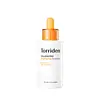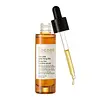What's inside
What's inside
 Key Ingredients
Key Ingredients

 Benefits
Benefits

 Concerns
Concerns

 Ingredients Side-by-side
Ingredients Side-by-side

Water
Skin ConditioningPropanediol
SolventGlycerin
HumectantNiacinamide
Smoothing3-O-Ethyl Ascorbic Acid
Skin Conditioning1,2-Hexanediol
Skin ConditioningIsopropyl Myristate
EmollientBetaine
HumectantErythritol
HumectantAdenosine
Skin ConditioningAllantoin
Skin ConditioningTocopherol
AntioxidantPanthenol
Skin ConditioningAscorbic Acid
AntioxidantSodium Ascorbyl Phosphate
AntioxidantAscorbyl Glucoside
AntioxidantAscorbyl Palmitate
AntioxidantEthylhexylglycerin
Skin ConditioningCaprylyl Glycol
EmollientXanthan Gum
EmulsifyingCorallina Officinalis Extract
Skin ConditioningEcklonia Cava Extract
Skin ConditioningCodium Tomentosum Extract
Skin ProtectingGelidium Cartilagineum Extract
Skin ProtectingHizikia Fusiforme Extract
Skin ConditioningOctyldodecanol
EmollientAcrylates/C10-30 Alkyl Acrylate Crosspolymer
Emulsion StabilisingTromethamine
BufferingDisodium EDTA
Methylpropanediol
SolventFerulic Acid
AntimicrobialOcimum Sanctum Leaf Extract
Skin ConditioningButylene Glycol
HumectantHydrogenated Lecithin
EmulsifyingCitrus Aurantium Bergamia Fruit Oil
MaskingMelia Azadirachta Leaf Extract
Skin ConditioningMelia Azadirachta Flower Extract
Skin ConditioningCurcuma Longa Root Extract
MaskingWater, Propanediol, Glycerin, Niacinamide, 3-O-Ethyl Ascorbic Acid, 1,2-Hexanediol, Isopropyl Myristate, Betaine, Erythritol, Adenosine, Allantoin, Tocopherol, Panthenol, Ascorbic Acid, Sodium Ascorbyl Phosphate, Ascorbyl Glucoside, Ascorbyl Palmitate, Ethylhexylglycerin, Caprylyl Glycol, Xanthan Gum, Corallina Officinalis Extract, Ecklonia Cava Extract, Codium Tomentosum Extract, Gelidium Cartilagineum Extract, Hizikia Fusiforme Extract, Octyldodecanol, Acrylates/C10-30 Alkyl Acrylate Crosspolymer, Tromethamine, Disodium EDTA, Methylpropanediol, Ferulic Acid, Ocimum Sanctum Leaf Extract, Butylene Glycol, Hydrogenated Lecithin, Citrus Aurantium Bergamia Fruit Oil, Melia Azadirachta Leaf Extract, Melia Azadirachta Flower Extract, Curcuma Longa Root Extract
Water
Skin Conditioning3-O-Ethyl Ascorbic Acid
Skin ConditioningCaprylic/Capric/Succinic Triglyceride
EmollientNiacinamide
SmoothingPotassium Azeloyl Diglycinate
Skin ConditioningAcetyl Glucosamine
Skin ConditioningDimethyl Isosorbide
Solvent1-Methylhydantoin-2-Imide
Skin ConditioningPropanediol
SolventCurcuma Longa Root Oil
PerfumingCurcuma Longa Root Extract
MaskingDaucus Carota Sativa Root Extract
Skin ConditioningBetaine
HumectantGlycerin
HumectantHydroxyacetophenone
AntioxidantButylene Glycol
HumectantBeta-Carotene
Skin ConditioningGlycine Soja Oil
EmollientTocopherol
AntioxidantXanthan Gum
EmulsifyingEthylhexylglycerin
Skin ConditioningSodium Chloride
MaskingTrisodium Ethylenediamine Disuccinate
Phenoxyethanol
PreservativeWater, 3-O-Ethyl Ascorbic Acid, Caprylic/Capric/Succinic Triglyceride, Niacinamide, Potassium Azeloyl Diglycinate, Acetyl Glucosamine, Dimethyl Isosorbide, 1-Methylhydantoin-2-Imide, Propanediol, Curcuma Longa Root Oil, Curcuma Longa Root Extract, Daucus Carota Sativa Root Extract, Betaine, Glycerin, Hydroxyacetophenone, Butylene Glycol, Beta-Carotene, Glycine Soja Oil, Tocopherol, Xanthan Gum, Ethylhexylglycerin, Sodium Chloride, Trisodium Ethylenediamine Disuccinate, Phenoxyethanol
 Reviews
Reviews

Ingredients Explained
These ingredients are found in both products.
Ingredients higher up in an ingredient list are typically present in a larger amount.
You might know this ingredient as Ethyl Ascorbic Acid, a more stable version of ascorbic acid.
Like other types of vitamin C, this ingredient has many benefits including reducing wrinkles, skin soothing, dark spot fading, and fighting against free radicals.
3-O-Ethyl Ascorbic Acid interferes with the process of skin darkening, helping to reduce hyperpigmentation. It also encourages the skin to produce more collagen.
Once applied, 3-O-Ethyl Ascorbic Acid is converted to Vitamin C deeper in the skin's layers. This process is slow but makes this ingredient more tolerable for skin.
The optimum pH range for this ingredient is 4 - 5.5
Learn more about 3-O-Ethyl Ascorbic AcidBetaine is a common humectant (a substance that promotes retention of moisture). It's known to be gentle on the skin and can help balance hydration.
This ingredient is best for improving hydration and soothing irritated skin. Studies also show it helps even out skin tone.
Fun fact: Betaine is naturally created in the skin and body. The kind found within cosmetic products can be either plant-derived or synthetic.
Another name for betaine is trimethylglycine.
Learn more about BetaineButylene Glycol (or BG) is used within cosmetic products for a few different reasons:
Overall, Butylene Glycol is a safe and well-rounded ingredient that works well with other ingredients.
Though this ingredient works well with most skin types, some people with sensitive skin may experience a reaction such as allergic rashes, closed comedones, or itchiness.
Learn more about Butylene GlycolCurcuma Longa Root Extract is from the spice, turmeric. Besides being a healthy and delicious spice, turmeric also has plenty of skincare benefits. It has anti-inflammatory, antioxidant, and anti-microbial properties.
Turmeric contains curcumin, an antioxidant. Antioxidants help neutralize unstable free-radical molecules. Free-radical molecules may damage your skin's cells and DNA. Curcumin may help with anti-aging.
Curcumin also has anti-inflammatory properties and can help soothe skin and reduce irritation. On top of that, curcumin has been shown to help prevent hyperpigmentation from sun damage.
The anti-microbial property of turmeric can make it effective in treating acne. This property has also been shown to help regulate the production of sebum.
Learn more about Curcuma Longa Root ExtractEthylhexylglycerin (we can't pronounce this either) is commonly used as a preservative and skin softener. It is derived from glyceryl.
You might see Ethylhexylglycerin often paired with other preservatives such as phenoxyethanol. Ethylhexylglycerin has been found to increase the effectiveness of these other preservatives.
Glycerin is already naturally found in your skin. It helps moisturize and protect your skin.
A study from 2016 found glycerin to be more effective as a humectant than AHAs and hyaluronic acid.
As a humectant, it helps the skin stay hydrated by pulling moisture to your skin. The low molecular weight of glycerin allows it to pull moisture into the deeper layers of your skin.
Hydrated skin improves your skin barrier; Your skin barrier helps protect against irritants and bacteria.
Glycerin has also been found to have antimicrobial and antiviral properties. Due to these properties, glycerin is often used in wound and burn treatments.
In cosmetics, glycerin is usually derived from plants such as soybean or palm. However, it can also be sourced from animals, such as tallow or animal fat.
This ingredient is organic, colorless, odorless, and non-toxic.
Glycerin is the name for this ingredient in American English. British English uses Glycerol/Glycerine.
Learn more about GlycerinNiacinamide is a multitasking form of vitamin B3 that strengthens the skin barrier, reduces pores and dark spots, regulates oil, and improves signs of aging.
And the best part? It's gentle and well-tolerated by most skin types, including sensitive and reactive skin.
You might have heard of "niacin flush", or the reddening of skin that causes itchiness. Niacinamide has not been found to cause this.
In very rare cases, some individuals may not be able to tolerate niacinamide at all or experience an allergic reaction to it.
If you are experiencing flaking, irritation, and dryness with this ingredient, be sure to double check all your products as this ingredient can be found in all categories of skincare.
When incorporating niacinamide into your routine, look out for concentration amounts. Typically, 5% niacinamide provides benefits such as fading dark spots. However, if you have sensitive skin, it is better to begin with a smaller concentration.
When you apply niacinamide to your skin, your body converts it into nicotinamide adenine dinucleotide (NAD). NAD is an essential coenzyme that is already found in your cells as "fuel" and powers countless biological processes.
In your skin, NAD helps repair cell damage, produce new healthy cells, support collagen production, strengthen the skin barrier, and fight environmental stressors (like UV and pollution).
Our natural NAD levels start to decline with age, leading to slower skin repair, visible aging, and a weaker skin barrier. By providing your skin niacinamide, you're recharging your skin's NAD levels. This leads to stronger, healthier, and younger looking skin.
Another name for vitamin B3 is nicotinamide. This vitamin is water-soluble and our bodies don't store it. We obtain Vitamin B3 from either food or skincare. Meat, fish, wheat, yeast, and leafy greens contain vitamin B3.
The type of niacinamide used in skincare is synthetically created.
Learn more about NiacinamidePropanediol is an all-star ingredient. It softens, hydrates, and smooths the skin.
It’s often used to:
Propanediol is not likely to cause sensitivity and considered safe to use. It is derived from corn or petroleum with a clear color and no scent.
Learn more about PropanediolTocopherol (also known as Vitamin E) is a common antioxidant used to help protect the skin from free-radicals and strengthen the skin barrier. It's also fat soluble - this means our skin is great at absorbing it.
Vitamin E also helps keep your natural skin lipids healthy. Your lipid skin barrier naturally consists of lipids, ceramides, and fatty acids. Vitamin E offers extra protection for your skin’s lipid barrier, keeping your skin healthy and nourished.
Another benefit is a bit of UV protection. Vitamin E helps reduce the damage caused by UVB rays. (It should not replace your sunscreen). Combining it with Vitamin C can decrease sunburned cells and hyperpigmentation after UV exposure.
You might have noticed Vitamin E + C often paired together. This is because it is great at stabilizing Vitamin C. Using the two together helps increase the effectiveness of both ingredients.
There are often claims that Vitamin E can reduce/prevent scarring, but these claims haven't been confirmed by scientific research.
Learn more about TocopherolWater. It's the most common cosmetic ingredient of all. You'll usually see it at the top of ingredient lists, meaning that it makes up the largest part of the product.
So why is it so popular? Water most often acts as a solvent - this means that it helps dissolve other ingredients into the formulation.
You'll also recognize water as that liquid we all need to stay alive. If you see this, drink a glass of water. Stay hydrated!
Learn more about WaterXanthan gum is used as a stabilizer and thickener within cosmetic products. It helps give products a sticky, thick feeling - preventing them from being too runny.
On the technical side of things, xanthan gum is a polysaccharide - a combination consisting of multiple sugar molecules bonded together.
Xanthan gum is a pretty common and great ingredient. It is a natural, non-toxic, non-irritating ingredient that is also commonly used in food products.
Learn more about Xanthan Gum